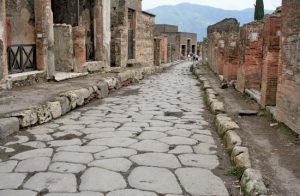Garbage is a term that evokes images of filth and grime. However, garbage is useful to archaeology. Recently, archaeologists have analyzed garbage in landfills to gain better insight into the way people think and to better understand cultures and their value systems. Landfills can be found all over the globe, but finding garbage from the distant past proves more difficult, as archaeologists must find sites where refuse is still intact. Fortunately, many of these kinds of sites have been identified.
Interestingly, some of the best preserved garbage from the past few centuries has been found in toilets. A team of archaeologists recently uncovered a number of privy pits in Philadelphia, PA, from the 18th century. One of these pits was dated to 1776, placing it and its contents at the beginning of the American Revolution both in location and time. It is more than likely that this pit was dug around the time when Benjamin and Mary Humphreys bought a house at its location on July 10th, 1776. This pit, labelled Feature 16, had an interesting array of refuse within. In one of the holes, items typical of a tavern were found, such as tankards, drinking glasses, bowls, and alcohol bottles, many of which had been patched or repaired. Using paper records, the archaeologists found that Mary Humphreys had been arrested in July of 1783 for running an illegal tavern. These two radically different pieces of evidence work together to tell a story of a Revolutionary-era woman and her “disorderly house.”

The remains of a punch bowl found in Feature 16. The ship depicted carried a message from Philadelphia to Great Britain to pressure Parliament into repealing the Stamp Act in 1765.
Recent archaeological studies in Pompeii have been focused on studying garbage to understand how ancient people disposed of their unwanted goods. Researchers found cracked dishware, dented metal-ware, and items with broken handles in an old farmhouse, and patched amphoras at a wine-bottling facility, which would suggest that these Romans did not throw things away and instead repaired and reused them until they were completely unusable. Archaeologists have also not been able to locate glass or ceramics on the streets of the ancient city, furthering this theory.
Analyzing garbage from before the Industrial Revolution reveals much about how people valued their belongings. After the Industrial Revolution, the concept of “disposable goods” arose. This is evident in what we throw away, from plastic wrap to half eaten meals. Garbage found from before this time reveals reveals artifacts that had been patched up and repaired numerous times until they were no longer usable. This reflects an entirely different mentality. What was thrown away had value, and was only discarded reluctantly after it had been well-worn. Histories gleaned from garbage are important, but understanding how people value their belongings is just as important to archaeology.
Links:
http://www.archaeology.org/news/5217-170120-italy-pompeii-trash
Images:
Further Reading:


As you mentioned Trash sites are a great to learn how a culture values their material world, how well can we learn from trash of cultural interaction with other groups? Are there examples of trash sites where we can see relationships between distinct groups?